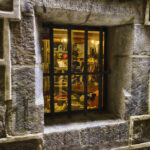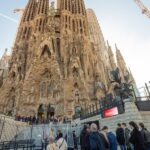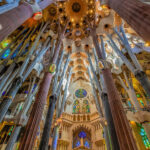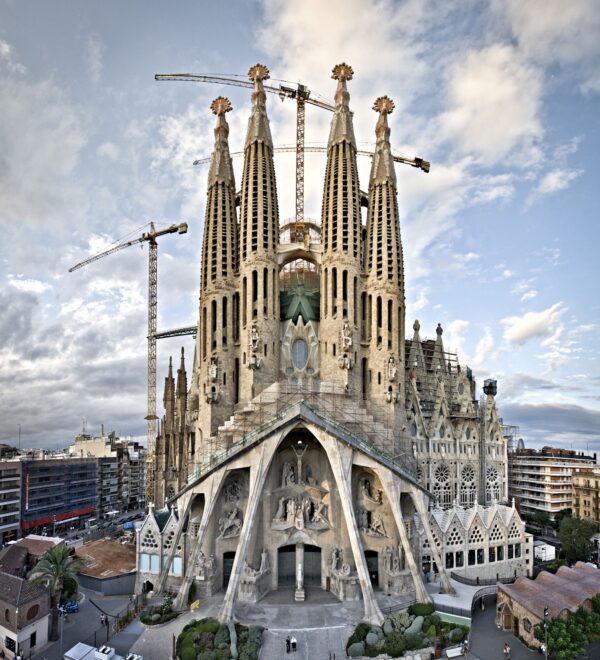
The Sagrada Familia, an iconic symbol of Barcelona, is not just a remarkable architectural wonder but also a profound expression of faith and creativity. Designed by the visionary architect Antoni Gaudí, its construction began in 1882 and continues to this day, making it a unique testament to the evolving nature of art and spirituality.
Exploring The Fascinating History of Sagrada Familia in Barcelona, Spain reveals a story of ambition, innovation, and devotion. Each intricate detail and towering spire reflects Gaudí's deep connection to nature and his unwavering commitment to creating a masterpiece that transcends time.
The Architectural Marvel: A Deep Dive into the Sagrada Familia's Design
The Sagrada Familia embodies a stunning blend of Gothic and Art Nouveau styles, making it a unique architectural marvel. Gaudí's design is characterized by its organic shapes, asymmetry, and the use of light, which creates an ethereal atmosphere within the basilica. The intricate facades depict various biblical stories, showcasing his ability to convey profound narratives through stone.
One of the most remarkable aspects of the Sagrada Familia's design is its structural innovation. Gaudí employed a technique known as "hyperboloid" geometry, which allows for both strength and beauty. This method is evident in features such as the massive columns that resemble trees, providing both support and a natural aesthetic. Key design elements include:
- Helical staircases
- Vaulted ceilings mimicking nature
- Richly adorned interiors inspired by flora
Another essential feature of the Sagrada Familia is its colorful stained glass windows, designed to fill the interior with a kaleidoscope of light. The use of varying hues not only enhances the spiritual ambiance but also reflects Gaudí's deep appreciation for nature. This interplay of light and color is meant to evoke a sense of divine presence within the sacred space.
The ambitious scale of the Sagrada Familia is also worth noting. Once completed, it will stand at a height of 172.5 meters, making it one of the tallest basilicas in the world. The construction process continues to employ traditional techniques alongside modern technology, ensuring that Gaudí's vision is honored while adapting to contemporary needs. This dedication to both heritage and innovation underscores the lasting significance of this architectural masterpiece.
Gaudí's Vision: The Inspiration Behind Sagrada Familia's Unique Structure
Gaudí's vision for the Sagrada Familia was deeply rooted in his passion for nature. He believed that the organic forms found in the natural world could inspire a new architectural language. This belief led him to incorporate elements such as tree-like columns and intricate facades that mimic the shapes of plants and flowers, creating a structure that feels alive and connected to its surroundings.
Another key aspect of Gaudí's inspiration was his profound religious faith. He envisioned the Sagrada Familia as a celestial symbol of Christianity, where each detail serves a spiritual purpose. For instance, the different facades represent significant events in the life of Jesus, intending to educate and inspire visitors about biblical narratives through architectural storytelling. This integration of faith with art is a hallmark of Gaudí's work.
Gaudí also drew inspiration from geometry and mathematics, particularly in the use of geometric forms that reflect both stability and beauty. The innovative "hyperboloid" shapes he employed not only ensure structural integrity but also enhance the aesthetic experience within the basilica. This mathematical precision is evident in the layout and elevation of the building, creating a harmonious balance between form and function.
In essence, Gaudí's vision for the Sagrada Familia is a synthesis of art, faith, and nature. His ability to transcend traditional architectural boundaries has resulted in a masterpiece that continues to inspire awe and wonder. As the basilica evolves, it stands as a testament to the enduring power of creativity and the deep connection between humanity and the divine.
Construction Timeline: Understanding the Historical Context of Sagrada Familia
The construction timeline of the Sagrada Familia spans over a century, reflecting not only the ambitious vision of Antoni Gaudí but also the historical context of Spain. The project began in 1882 under architect Francisco de Paula del Villar, but after a year, Gaudí took over, infusing it with his unique design philosophy. His work has continued through various political and social upheavals, contributing to the basilica's rich narrative.
Several significant milestones mark the journey of the Sagrada Familia's construction:
- 1882: Initial construction begins.
- 1883: Gaudí becomes the chief architect.
- 1936: Construction halts due to the Spanish Civil War.
- 2026: Estimated completion date for the centenary of Gaudí's death.
The historical context surrounding the Sagrada Familia is essential to understanding its construction. The changing political climate, particularly during the Spanish Civil War, led to the destruction of many of Gaudí's original models and plans. Despite these setbacks, the dedication to completing the basilica has remained strong, with ongoing efforts employing both traditional craftsmanship and modern technology.
In summary, the construction timeline of the Sagrada Familia is a testament to resilience and artistic ambition. Each phase of its development reflects not only Gaudí's vision but also the cultural and historical currents that have shaped Barcelona over the last century. As it continues to rise, the Sagrada Familia stands as a symbol of hope and innovation in architecture.
Symbolism and Meaning: The Religious Significance of Sagrada Familia
The Sagrada Familia is imbued with rich symbolism, deeply rooted in Christian teachings. Each of its elaborate facades and towers conveys significant religious narratives, inviting visitors to explore the life of Jesus Christ through architectural artistry. For instance, the Nativity Facade celebrates the birth of Christ, while the Passion Facade depicts his crucifixion, embodying the essence of sacrifice and redemption.
At the heart of the basilica's design lies the concept of spiritual awakening. Gaudí aimed to create a space where visitors could experience a profound connection to the divine. The interplay of light and color from the stained glass windows serves not only as a visual feast but also as a reminder of the transcendence of faith. This use of natural light symbolizes the presence of God, illuminating the sacred space with a heavenly glow.
Moreover, the structure itself is intended to reflect the cosmic order, resonating with Gaudí's belief in the harmony of the universe. The spiral forms and tree-like columns mimic natural elements, creating a sense of unity between the divine and the earthly. This connection emphasizes the idea that the Sagrada Familia is not just a church, but a bridge between humanity and the heavens.
The Sagrada Familia stands as a living testament to the intersection of art and faith. As it continues to evolve, it encapsulates the timeless values of love, hope, and devotion. Gaudí's vision persists in every stone and curve, making it a profound symbol of spiritual significance in Barcelona and beyond.
Visitor Experience: What to Expect When Exploring Sagrada Familia
When visiting the Sagrada Familia, guests can expect a mesmerizing journey through both architecture and spirituality. As you approach the basilica, the intricate facades come into view, each narrating stories from the Bible. Prepare to be captivated by the stunning details that reveal Gaudí's artistic vision, allowing visitors to engage with the structural elements that symbolize key moments in Christian doctrine.
Inside, the atmosphere shifts dramatically. The play of natural light filtering through the vibrant stained glass windows creates a dynamic spectacle that changes throughout the day. This colorful illumination not only enhances the aesthetics but also fosters a meditative space, inviting guests to reflect on their own spiritual journeys amidst the towering columns that resemble trees, embodying Gaudí's profound connection to nature.
To fully appreciate the Sagrada Familia, consider joining a guided tour, which provides insights into the architectural techniques and artistic choices made by Gaudí. Highlights of a typical visit may include:
- A deep dive into the significance of the Nativity and Passion Facades
- Understanding the structural innovations, such as the hyperboloid forms
- Observing ongoing construction efforts that honor Gaudí's vision
As you conclude your visit, take a moment to step back and admire the basilica from different angles. The Sagrada Familia is designed not just for interior exploration but to be appreciated as a whole. Each perspective offers new insights into its grandeur, making every visit a unique experience that resonates long after you leave its sacred grounds.
Sagrada Familia's Cultural Impact: Influence on Art and Architecture in Barcelona
The Sagrada Familia's influence extends far beyond its stunning facade, profoundly impacting the cultural landscape of Barcelona. The basilica has inspired countless artists and architects, who draw upon its unique blend of Gothic and Modernist styles. Gaudí's innovative use of natural forms has encouraged a new wave of architectural expression, emphasizing the importance of integrating nature into urban design. This has led to a revitalization of traditional craftsmanship, as artisans strive to emulate Gaudí's meticulous attention to detail.
Additionally, the Sagrada Familia serves as a focal point for various artistic movements, including Surrealism and Postmodernism. Its bold shapes and vibrant colors have influenced contemporary artists, prompting them to explore themes of spirituality and organic beauty. The basilica's presence in the city has also fostered a sense of cultural identity among locals, uniting them in a shared appreciation for Gaudí's visionary work.
Moreover, the Sagrada Familia's cultural impact can be seen in the numerous events and festivals held in its vicinity, which celebrate both its architectural significance and the rich history of Barcelona. These events often feature:
- Art exhibitions showcasing local talents inspired by Gaudí
- Musical performances in the basilica's stunning acoustics
- Community gatherings that promote a collective appreciation for heritage
The ongoing construction of the Sagrada Familia continues to captivate global audiences, drawing millions of visitors each year. This enduring fascination highlights its role as a cultural beacon, symbolizing the resilience and creativity of Barcelona. As it nears completion, the basilica not only stands as a testament to Gaudí's genius but also as a source of inspiration for future generations of artists and architects alike.
 Discover unique boutiques and artisan shops in the Gothic Quarter
Discover unique boutiques and artisan shops in the Gothic Quarter The Ultimate Guide to Sagrada Familia Barcelona: How to Get Tickets and Make the Most of Your Visit
The Ultimate Guide to Sagrada Familia Barcelona: How to Get Tickets and Make the Most of Your Visit Ascending Elegance: Exploring the Stunning Staircase of La Sagrada Familia in Barcelona
Ascending Elegance: Exploring the Stunning Staircase of La Sagrada Familia in BarcelonaIf you want to know other articles similar to The Fascinating History of Sagrada Familia in Barcelona, Spain you can visit the category WHERE YOU CAN GO.
Leave a Reply










Read more!